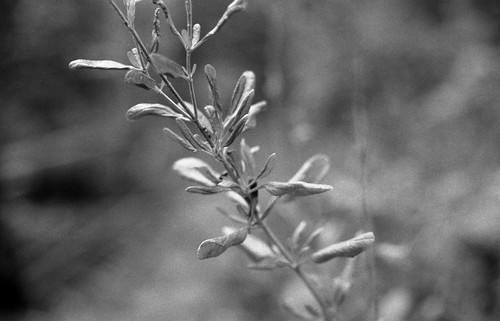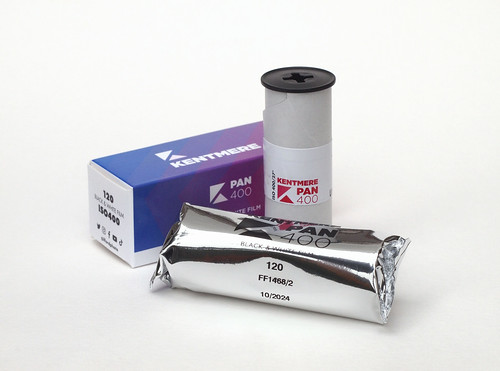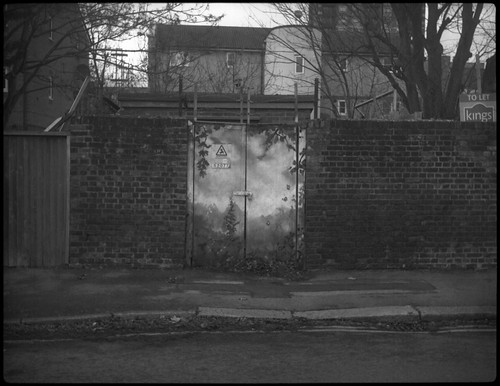 |
| Kentmere Pan 400 |
When I bought a few rolls of
Ilford Pan 400 earlier this year to test the film, following up my use of
Pan 100, I'd been informed that Pan 400 was to be discontinued, and that the Kentmere films, made by Harman, Ilford's parent company, were to fill their budget niche. The Kentmere films had been introduced around a decade ago after Ilford had acquired the old Kentmere brand; in their recent rebranding the Kentmere films had been given a rather prominent 'Pan' to the name (I imagine that photographers are supposed to refer to the film colloquially as 'K-Pan 400'). There have long been discussions online as to whether or not the Kentmere 100/400 emulsions are the same as the Rollei RPX and the (new) Agfaphoto APX films in those speeds (not to forget the Fotoimpex CHM Universal films as well; but these seem to be less widely available). I have used
Rollei RPX 400 quite frequently, but particularly in medium format. Kentmere Pan 400, like the Ilford Pan films is only available in 35mm currently, and, having been around for many years is unlikely to suddenly be offered in medium and large format, although this is not impossible: Ilford's Ortho Plus film, a niche sheet film emulsion for decades, has just been introduced in 35mm and 120.
I had used a few rolls of
Kentmere 400 (as it had been known) before, but my experience with the film was limited - and I hadn't tested it in any way. The relatively recent rebranding of the film, with the addition of 'Pan' to its name and the new packaging, as well as the rumour of Ilford Pan 400 being discontinued, suggests that Kentmere Pan 400 is a brand of film to be supported by Harman for the foreseeable future; this seemed to be a good opportunity to write a post about the film, as much as anything as a comparison to Ilford Pan 400.
For a first test with Kentmere Pan 400, as with other films, I shot a range of exposures for latitude, then developed the film as for box speed. On the contact sheet below, the first and second rows are rated, from left to right, 100/200/400/800/1600/3200; the third row is at box speed. This film was developed in R09 One Shot diluted 1+25 for 6m45s at 21ºC.
 |
| Kentmere Pan 400 latitude test |
My immediate impressions, which the contact sheet displays to some degree, is that Kentmere Pan 400 has better latitude than Ilford Pan 400, possibly with lower inherent contrast - to me, the two latitude tests certainly don't
look the same. Although there would be some variability in the tests, both were shot with the same
Canon A-1, of similar subjects, and developed in R09 at 1+25; the Kentmere Pan 400 was developed at a slightly higher temperature, as this was done on a warm day, which would be more likely to
increase contrast, which must have a bearing on latitude.
 |
| Kentmere Pan 400 rated 100, i.e. two stops overexposed |
 |
| Kentmere Pan 400 rated 1600, i.e. two stops underexposed |
At two stops overexposed, some tonal compression was evident but possibly acceptable; two stops underexposed also scanned well enough. Rated 3200, three stops under, shadow detail was clearly being lost to a greater degree at this point. This latitude test gave me some parameters for push processing; the
current data sheet for the film only lists times for 400 and 800 (and 320 for Perceptol). The Massive Dev Chart has very few times listed for Kentmere 400 at 1600 - and none with developers I habitually use. Previously, when rating Kentmere 400 at 1600, I'd used stand development with R09 at a dilution of 1+150 for 3 hours, which had been successful enough.
 |
| Kentmere 400 rated 1600, stand developed in R09 1+150 for 3 hours |
Obviously, three-hour stand development isn't always ideal. For this post, I used the
Massive Dev Chart formulation for pushing two stops: multiply the given time at box speed by a factor of two-and-a-half. In Ilfotec LC29 at a dilution of 1+19, this gave a result of 18 minutes at 20ºC - long, but not too long (a shorter result would have been achieved at a dilution of 1+9 of course). The results demonstrated that the film was easily capable of a two-stop push - which the latitude test appeared to show would be the case.
 |
| Kentmere Pan 400 rated 1600, developed in Ilfotec LC29 1+19, 18m at 20ºC |
It was logical to test the film with a three-stop push, rating it at 3200 to shoot - as with rating it at 1600, without any development times listed for this, I again used the Massive Dev Chart push-processing factors, which give four-and-a-half times for three stops. As the timings were in danger of getting rather long, I used Ilfotec LC29 at a dilution of 1+9, and a time of 19m30s at 20ºC, only later realising that my multiplication had been a little off, and it should have been 20m15s; I doubt an extra 45 seconds would have made much difference to the end result. The negatives showed a marked difference from those rated 1600 - with one further stop, in many of the frames, the shadow detail simply wasn't there any more. This was something that the latitude test bears out: at 3200, there isn't sufficient shadow detail to
overdevelop. With scenes such as the one below, overexposure and underdevelopment would help to counteract the inherent contrast present in most urban night scenes; of course, it would not then be possible to take the shot handheld, as I did here. The second image below, taken in daylight, provides a better range of tones, but is still high in contrast with little shadow detail (mostly obscured by the choice of subject matter: the busy frame makes this less noticeable).
 |
| Kentmere Pan 400, rated 3200, developed in Ilfotec LC29 1+9, 9m30s at 20ºC |
 |
| Kentmere Pan 400, rated 3200, developed in Ilfotec LC29 1+9, 9m30s at 20ºC |
As I was following the same set of parameters as my post for Ilford Pan 400, I did also shoot some Kentmere Pan 400 at 200, as I had done with the Ilford Pan film, although I would very rarely pull film one stop (the one difference with this particular test was that I'd shot the Ilford Pan 400 with a
Kiev-4 and the Kentmere Pan 400 with the Canon A-1 again). Here there were development times on the Massive Dev Chart which I did follow: 8 minutes in Ilfotec LC29 at a dilution of 1+19; the effect of pull-processing does appear to show a lessening of contrast in the frames. In the image below, with the near tree and foliage in shadow, and brighter highlights beyond, pulling the negative appears to have given the image more luminosity - although much of this might be through use of a yellow filter.
 |
| Kentmere Pan 400 rated 200, developed in Ilfotec LC29, 1+19, 8m at 20ºC |
As a general comparison with Ilford Pan 400, despite looking as though it has better latitude, Kentmere Pan 400 does not appear to push quite so well when rated at higher speeds, although the subjects shot with both films on each post aren't strictly comparable. I would however, broadly echo my conclusions on Ilford Pan 400 on my post about that film: there's nothing about Kentmere Pan 400 which is distinctively characteristic to distinguish it from other similar films at the same speed and price range; at the same time it's a perfectly good, competitively priced, all-round 35mm black and white film with a certain flexibility in exposure and development.
 |
| Kentmere Pan 400 rated 200, developed in Ilfotec LC29, 1+19, 8m at 20ºC |
 |
| Kentmere Pan 400 at box speed, developed in R09 One Shot |
 |
| Kentmere Pan 400 at 1600, developed in Ilfotec LC29 1+19 |
 |
| Kentmere 400 rated 1600, stand developed in R09 1+150 for 3 hours |
 |
| Kentmere Pan 400, rated 3200, developed in Ilfotec LC29 1+9, 9m30s at 20ºC |

































